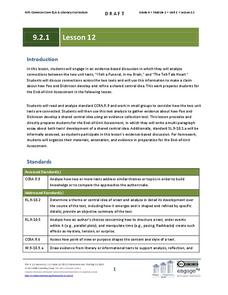EngageNY
Grade 10 ELA Module 1: Unit 1, Lesson 7
Can three works of literature work together to establish and develop a common central idea? Put your thoughts into writing with a final assessment focused on a unit-long analysis of Christopher Marlowe's "The Passionate Shepard to His...
EngageNY
Grade 9 ELA Module 2: Unit 1, Lesson 12
What happens when a tenuous grasp on sanity begins to slip? Compare Edgar Allan Poe's "The Tell-Tale Heart" and Emily Dickinson's "I Felt a Funeral, in my Brain" with a lesson plan focused on developing a common central idea. High...
K20 LEARN
But What About Me?: Teaching Perspective In The Social Studies Classroom
How would the story of the discovery of America be different if indigenous people told it through their eyes? Individuals compare the conventional account of this moment in history to an account given by one of the native peoples. After...
Scholastic
Defining Conflict Using "The Interlopers"
Feeling conflicted? Work out those issues with a language arts lesson on internal and external conflict. Using "The Interlopers" by Saki, class members identify the conflicts between the characters before writing their own short stories...
American Battlefield Trust
Creating Civil War Multimedia
What was it like to live through the Civil War? Learners investigate the question by creating multimedia presentations. With a scaffolded approach that includes research, creating a biopic poem, storyboard, and then polished multimedia...
US Institute of Peace
Perspectives on Peace
Is peace simply the absence of war, or is there more to the story? Young social scientists define peace in the second installment of a 15-part series. Groups work together to explore cultural concepts of peace and the peacemaking process...
EngageNY
Performance Task: Performing a Narrative
Calling all performers! Scholars present a modern-day theme of adversity by performing their narratives for the class. As individuals watch their peers, they take notes on each performance using an Audience Note Sheet.
Curated OER
Praise for a Color
Students discover the 5 senses by analyzing poetry. In this poetry lesson, students read a poem with their class and analyze how each sense plays into their understanding of the poem. Students write a poem based on a specific color...
Curated OER
Poetry: What's on Your Plate (Part 2)
Middle schoolers write a short paragraph using strong descriptions. In this using modifiers lesson, students define modifier, adjective, adverb, metaphor, and simile. Middle schoolers then write a journal entry in which they write...
Curated OER
Ode to the Ordinary
Ninth graders identify an ordinary object and write an ode for the subject. In this poetry writing lesson, 9th graders select an ordinary object and define its uses. Students then write an ode for the poem.
Curated OER
Teaching Sequence of Activities
Students develop their skills at writing poetry by listening to poetry and using a model to emulate and write a poem. In this poetry writing lesson, students listen to Louis MacNeice's poem 'Prayer Before Birth' and use it to model their...
Curated OER
The Search for Character!
Fifth graders define character words, look for real-life examples of the traits "in action," and write an acrostic poem based on one of these qualities.
Curated OER
Poetry in Motion
Young scholars choose a poetry theme. They write a poem, illustrate it with digital images and record it using a digital video camera.
Curated OER
Rhythm, Verse and Rhyme: COMPOSING A LIST POEM
Students are provided an opportunity for self-expression. They collaborate with a partner and compose a list poem. Students practice reading and writing skills. They explore lists and catalogues--both elements of poetry and practical...
Curated OER
Poetry and Emotional Health
Young scholars explore self-expression through poetry. In this personal health lessons students read and discuss poetry regarding teen topics of interest. Young scholars write poems, that express empathy.
Curated OER
Over the River and Through the Woods:Prepositional Poetry
Fifth graders will be able to identify and use prepositions correctly in written work.¿¿¿ They will also be able to identify poetic devices.They will see how their writing can be more descriptive and "visual" for their audience.
Curated OER
Poetry Reading for ELL Beginners
Bring the imagery of the desert to your classroom with this ELL lesson plan. After reading Madeleine Dunphy’s Here in the Southwestern Desert, learners complete a graphic organizer about the features and images of the poem. The...
Brethren High School
Romanticism Through the Eyes of Art, Poetry, and Technology
Use this simple collaborative activity to introduce the definition, art, and poetry of romanticism. Educators will have to provide the poetry, images of the art, and the survey for the learners, but by using this resource, they won't...
Curated OER
Prairie Poetry
Ninth graders take note of the ways in which word choice, rhythm, language and narrative voice, as well as point of view in a poem can be used to evoke a time and place. They use their insights to create a poem of their own.
Curated OER
Understanding Poetry
Students search the Internet to find a poem to research, analyze and present their interpretation of the poem to the class. They develop their interpretation in Microsoft Word and PowerPoint.
Curated OER
Analyzing Poetry with TPCASTT
Middle schoolers read a poem and complete a TPCASTT chart. They make a prediction about the title (T) , paraphrase each line (P), identify poetic devices and nuances (C-connotation), explore mood and tone (A-attitude), point out shifts...
Curated OER
Creature Feature Poetry Keyword Search!
Young scholars examine the differences between fact and opinion, and brainstorm ideas for a keyword list by analyzing facts. They listen to poems, and create posters listing three keywords about each creature featured in the poetry.
Curated OER
Use of Personification and Imagery in Poetry
A reading of Theodore Roethke’s dark "Root Cellar" and Sylvia Plath’s more abstract "Mirror" launches a discussion of imagery and personification in poetry. After finding examples of personification in the poems, class members craft...
Curated OER
Poetry--Homeless People
Eighth graders create a poem about homeless people using images they saw on websites. After reading the book "The Outsiders", 8th graders make connections of real life homeless people with characters in the book. Students search the web...

























